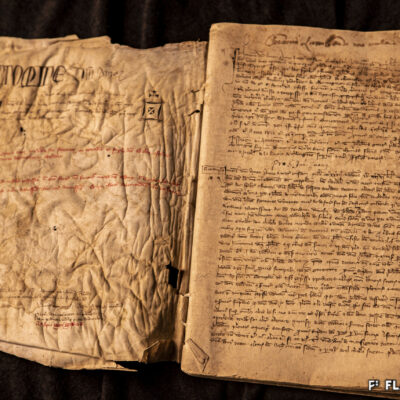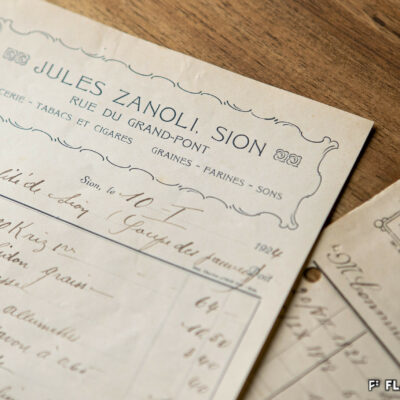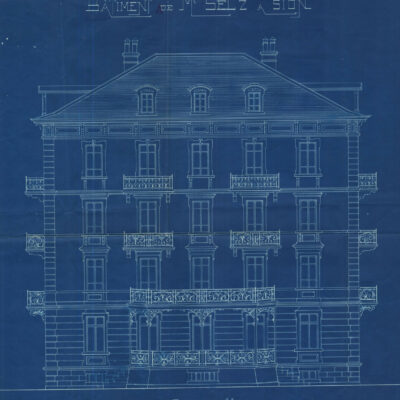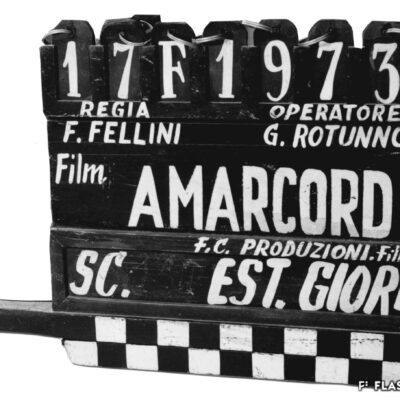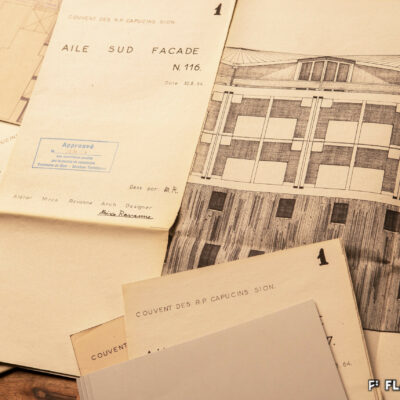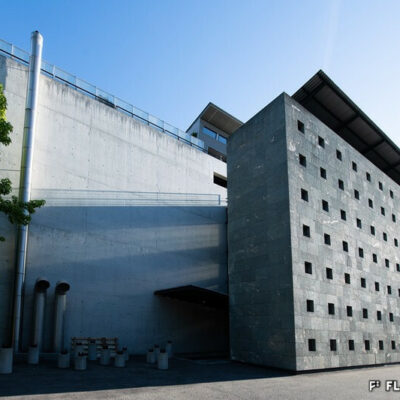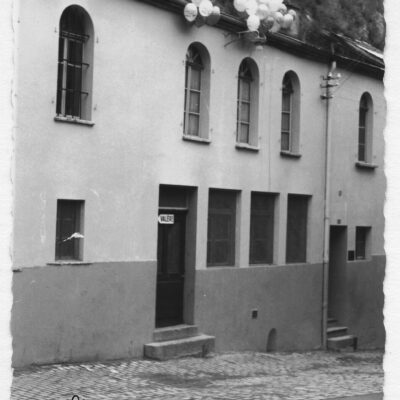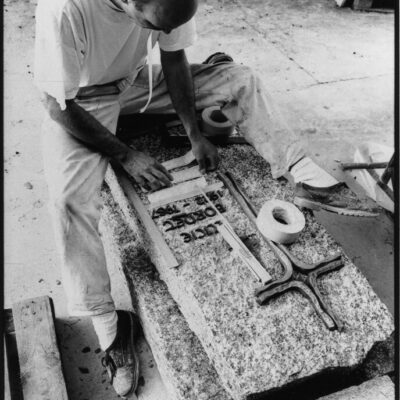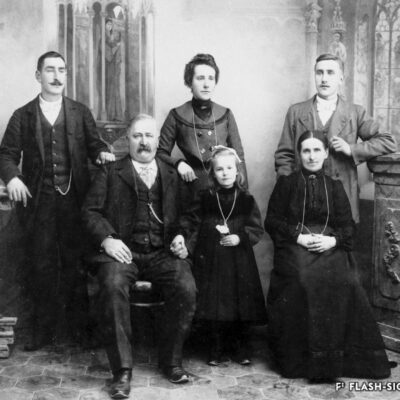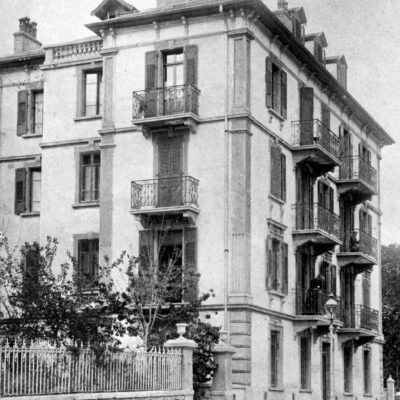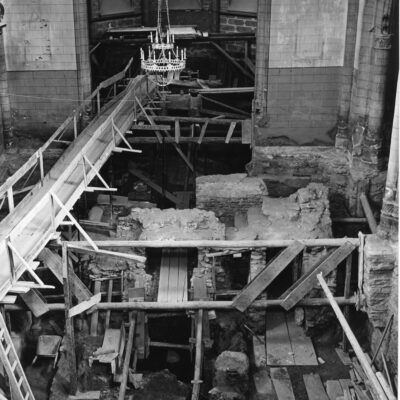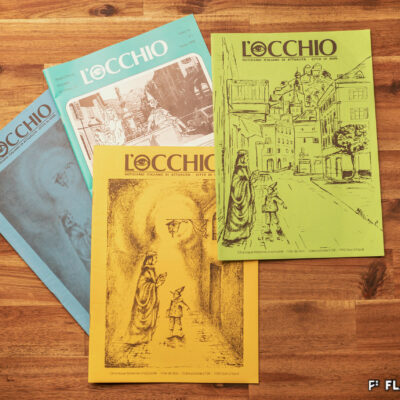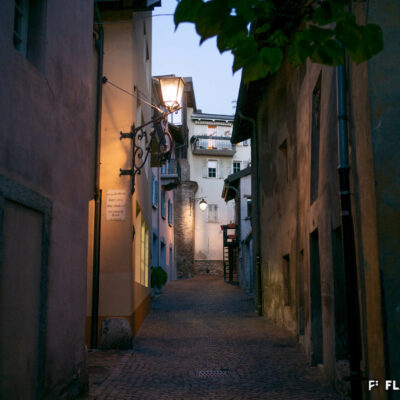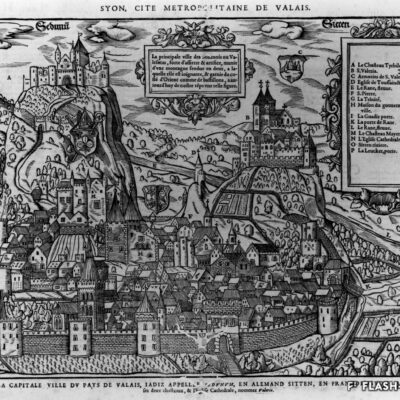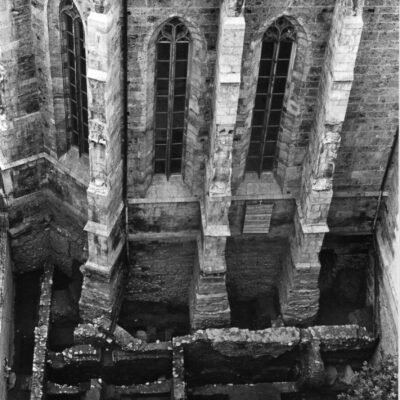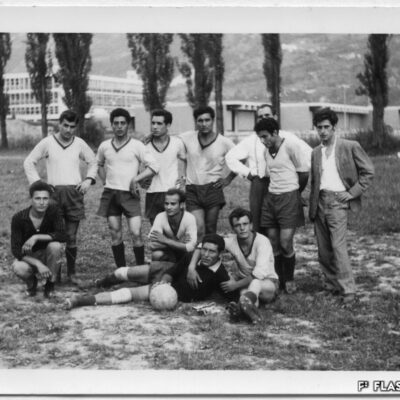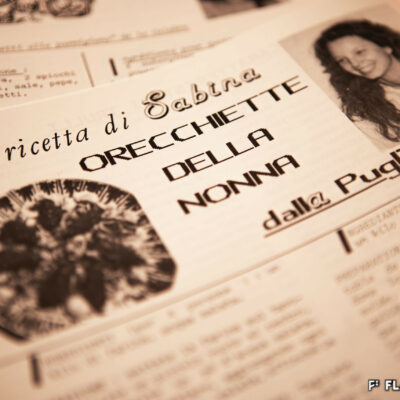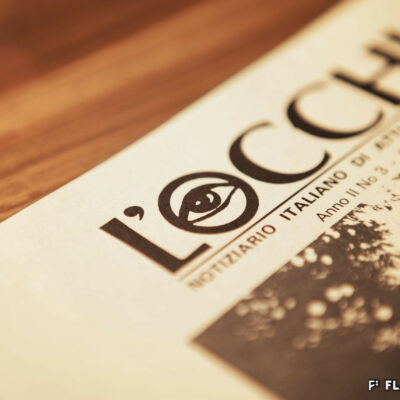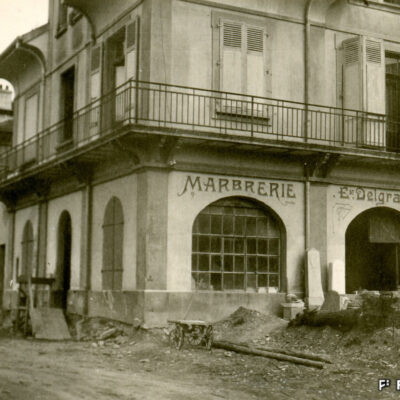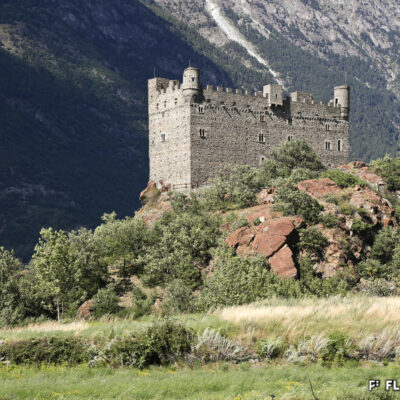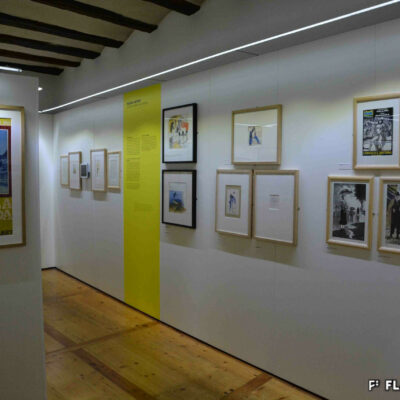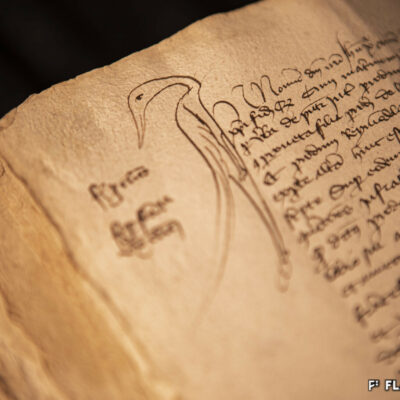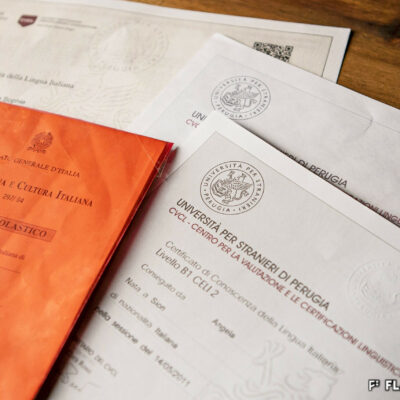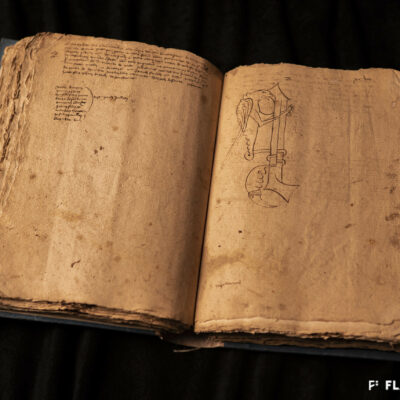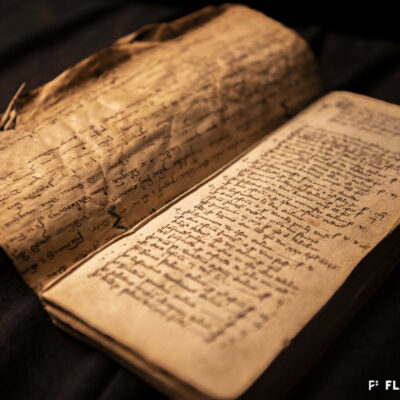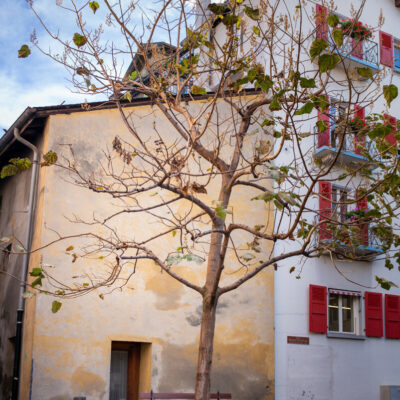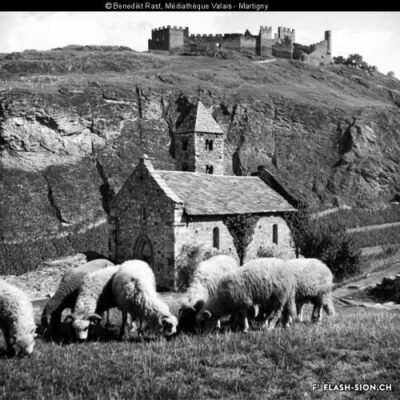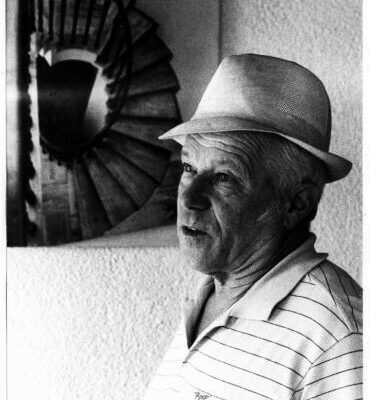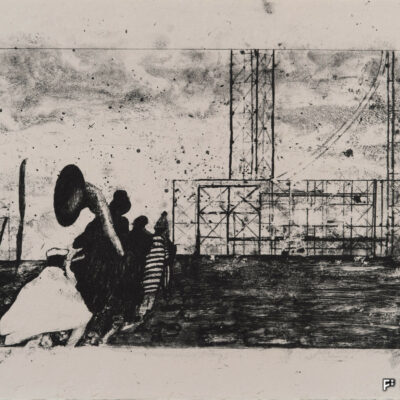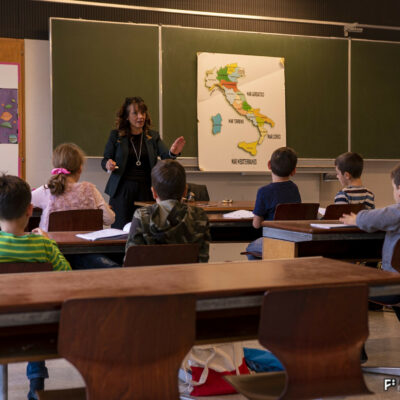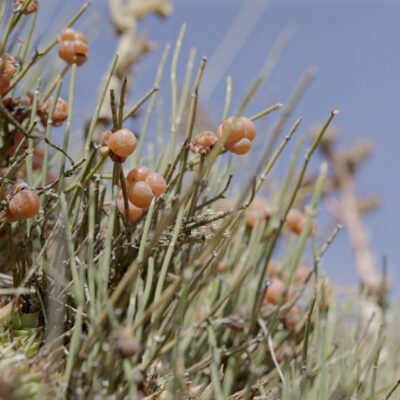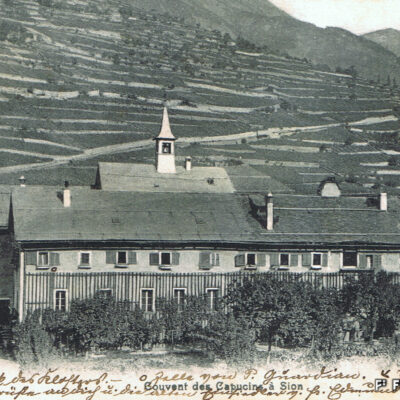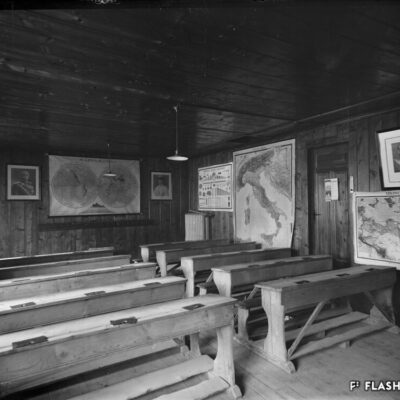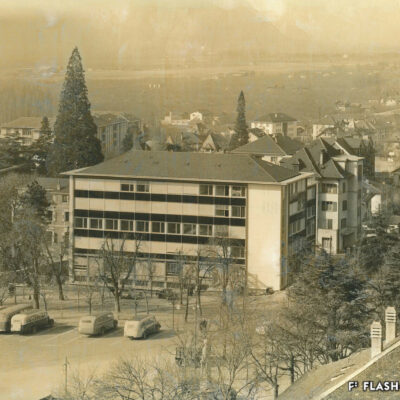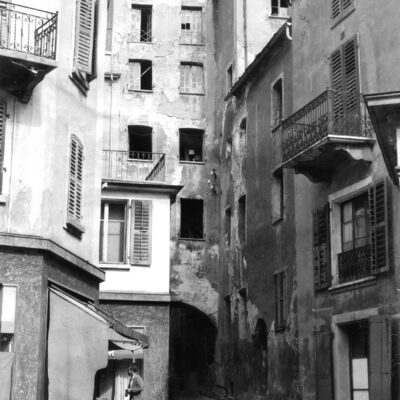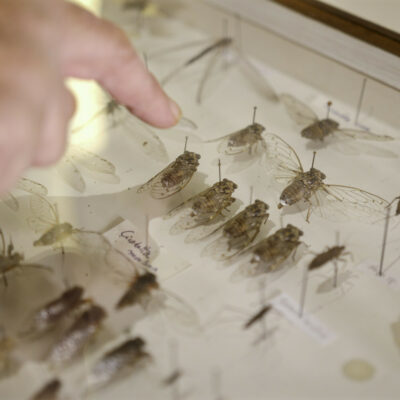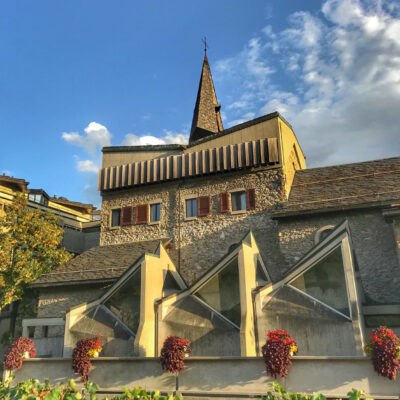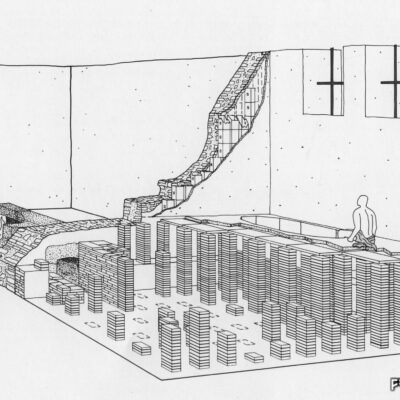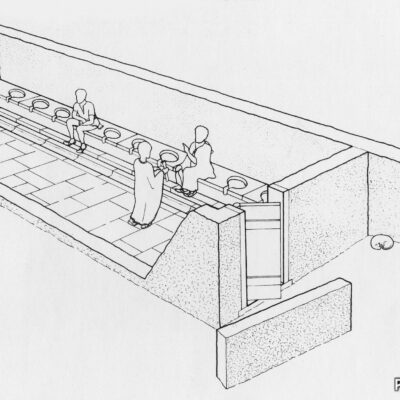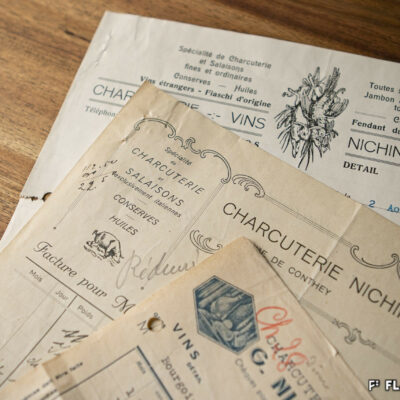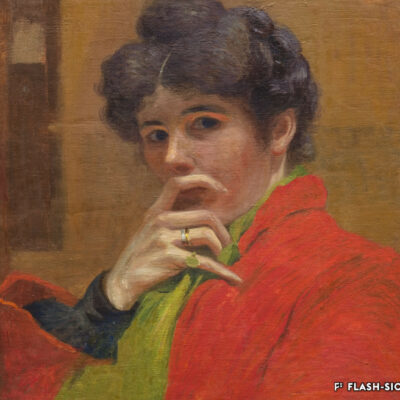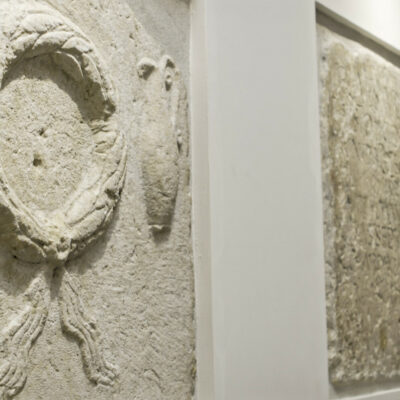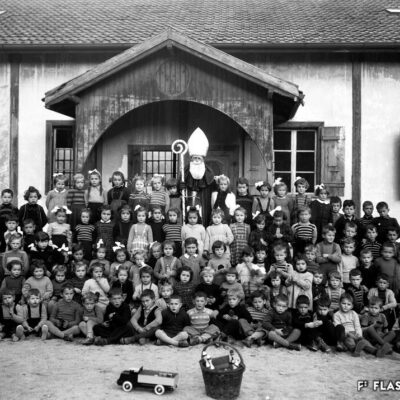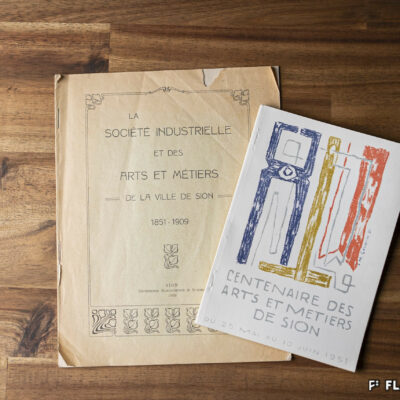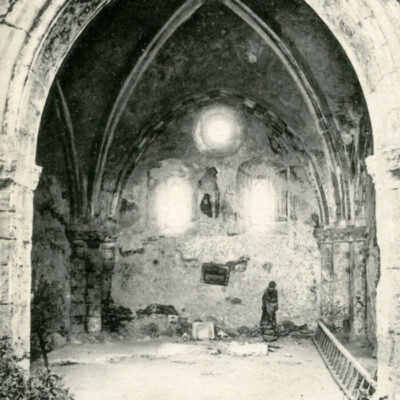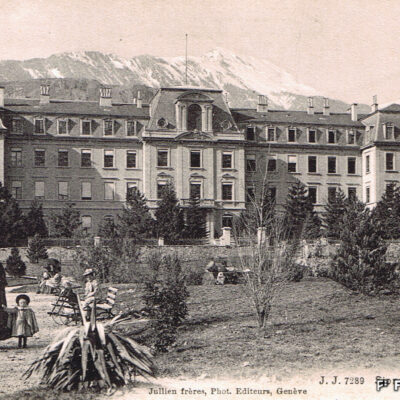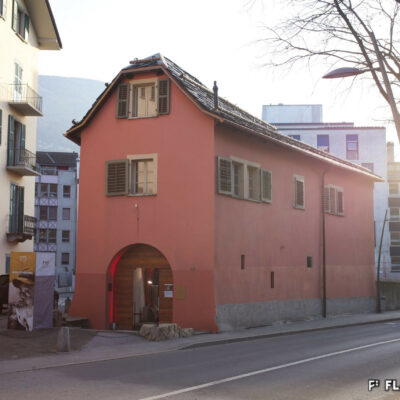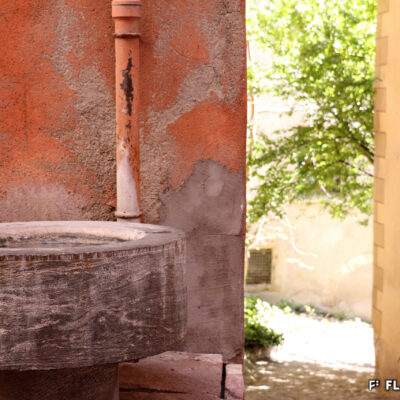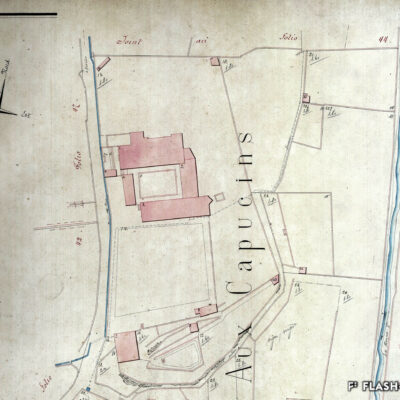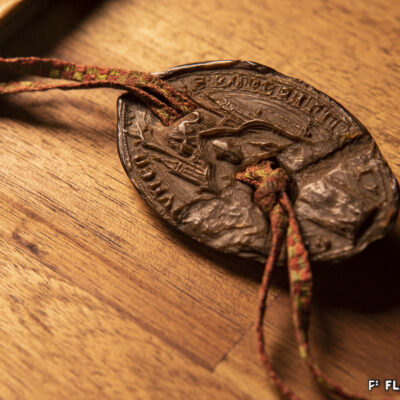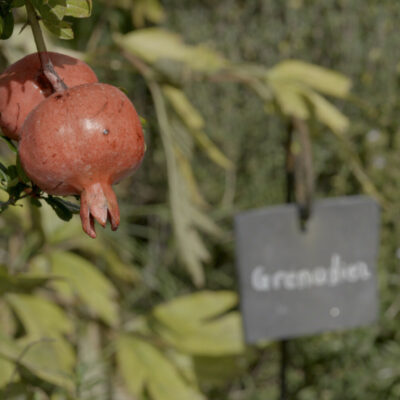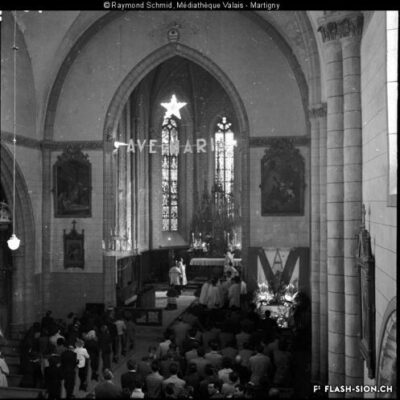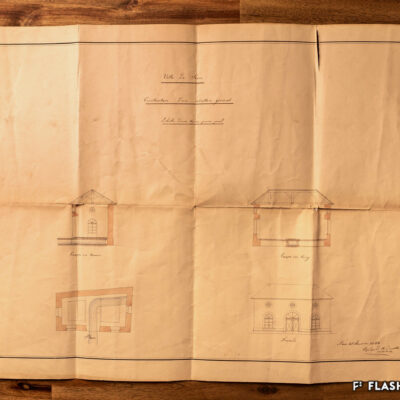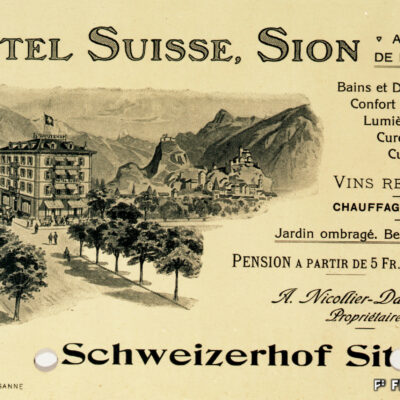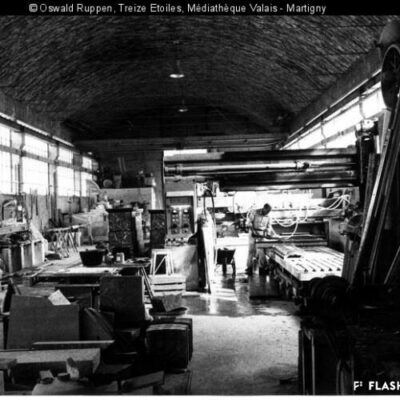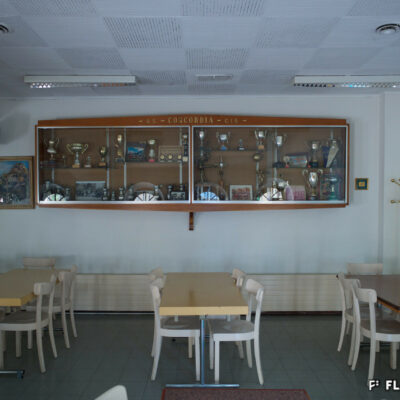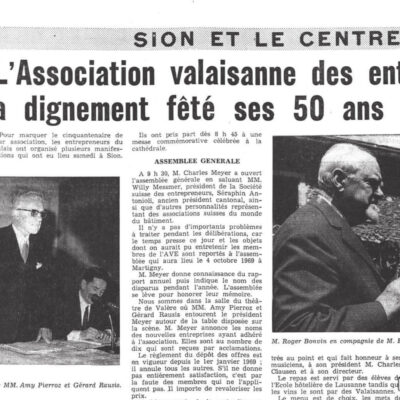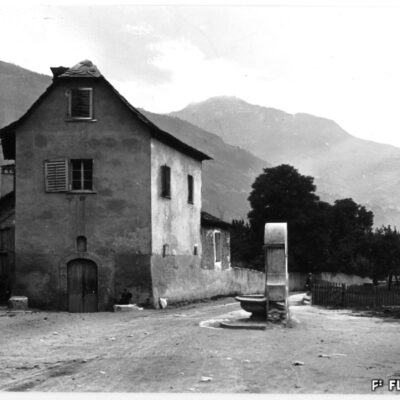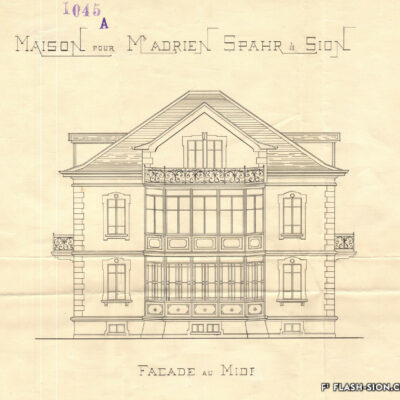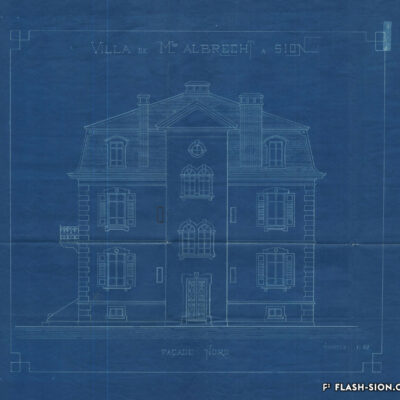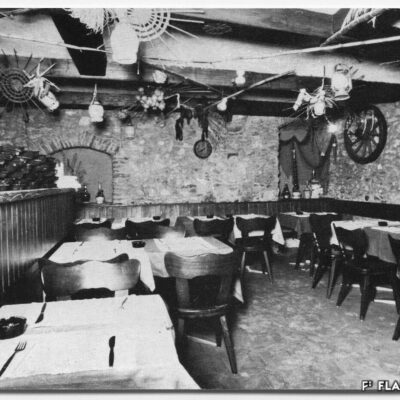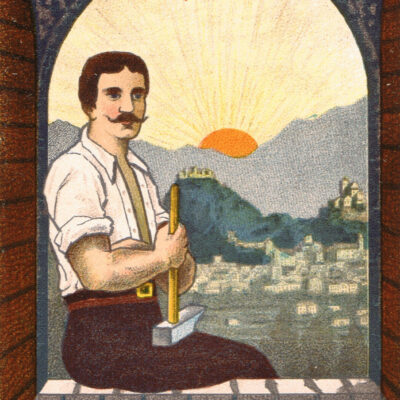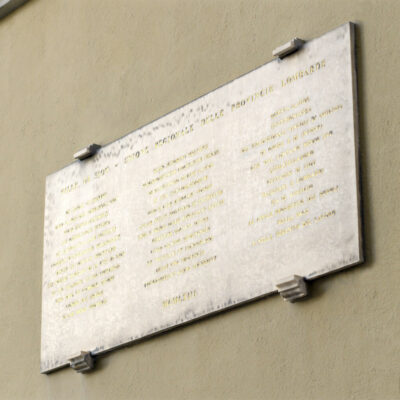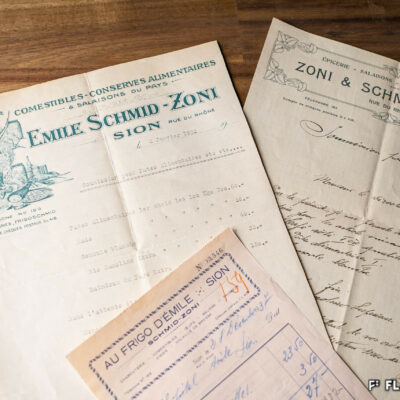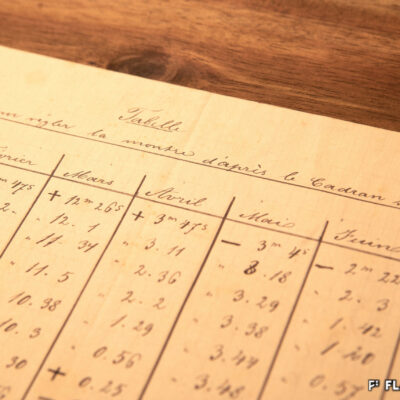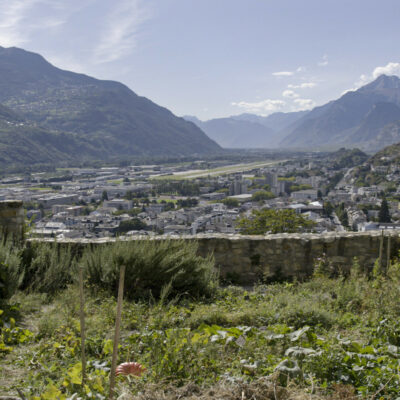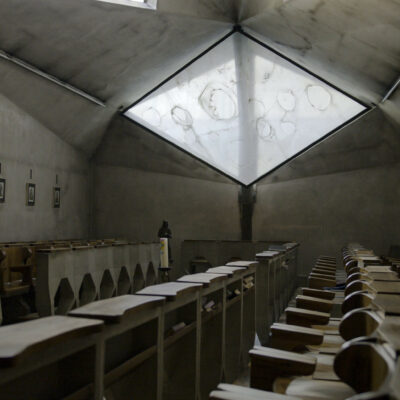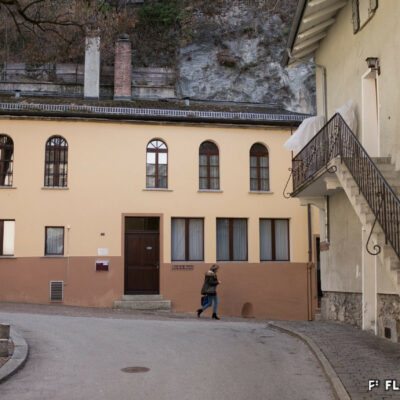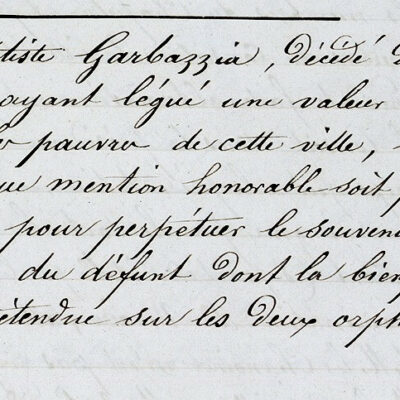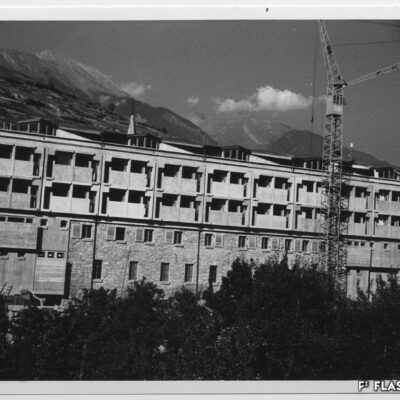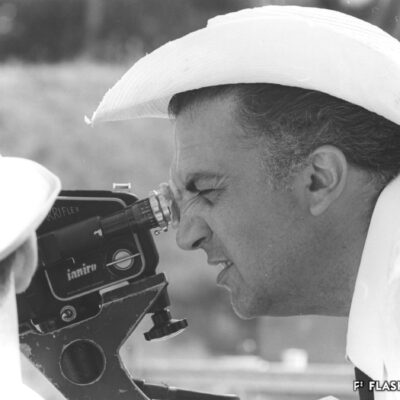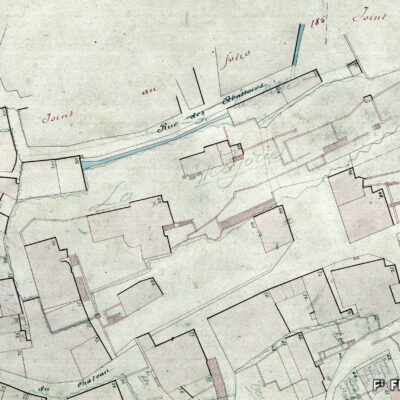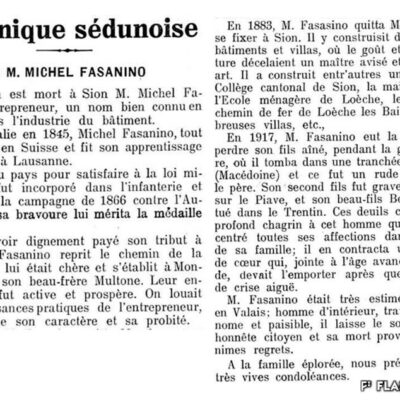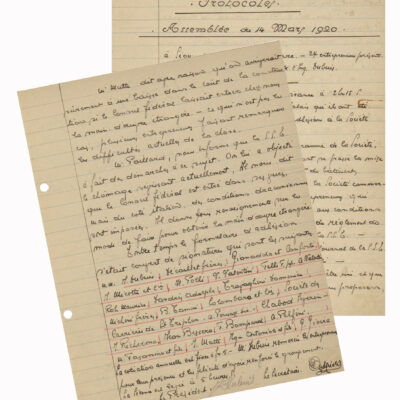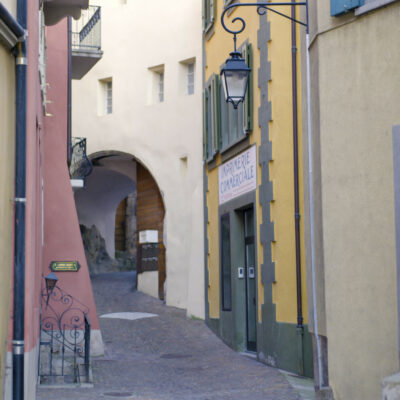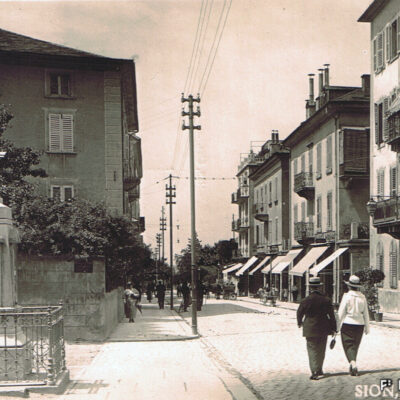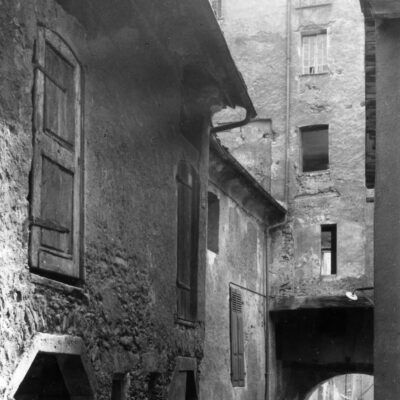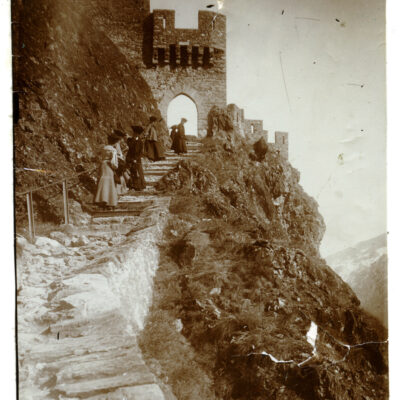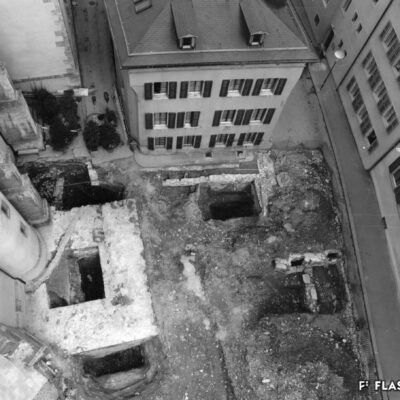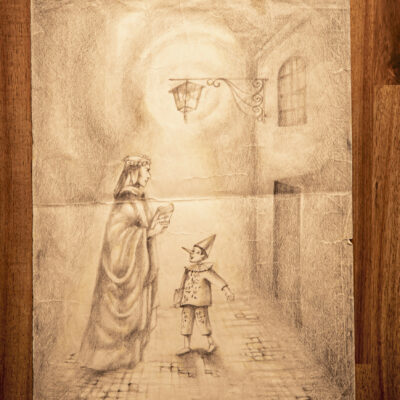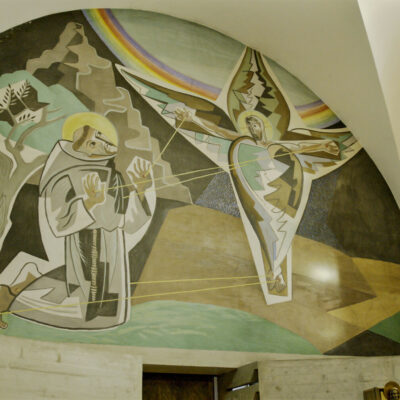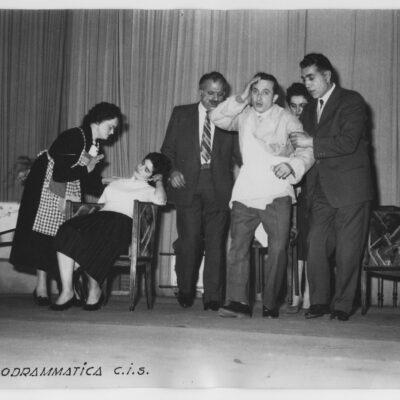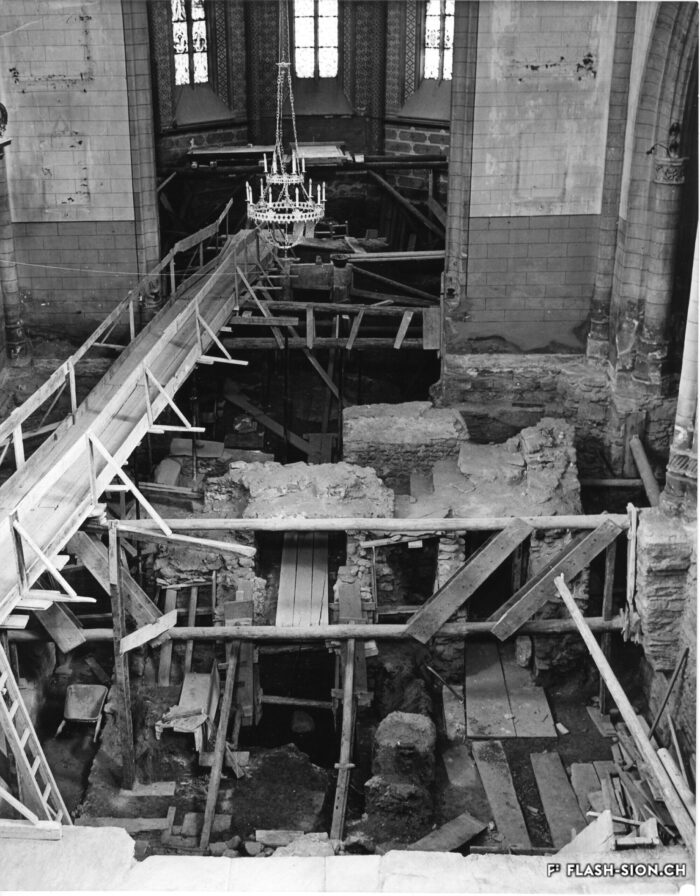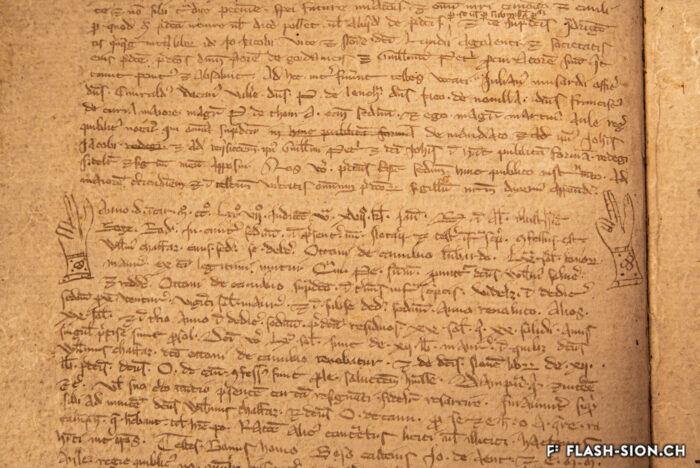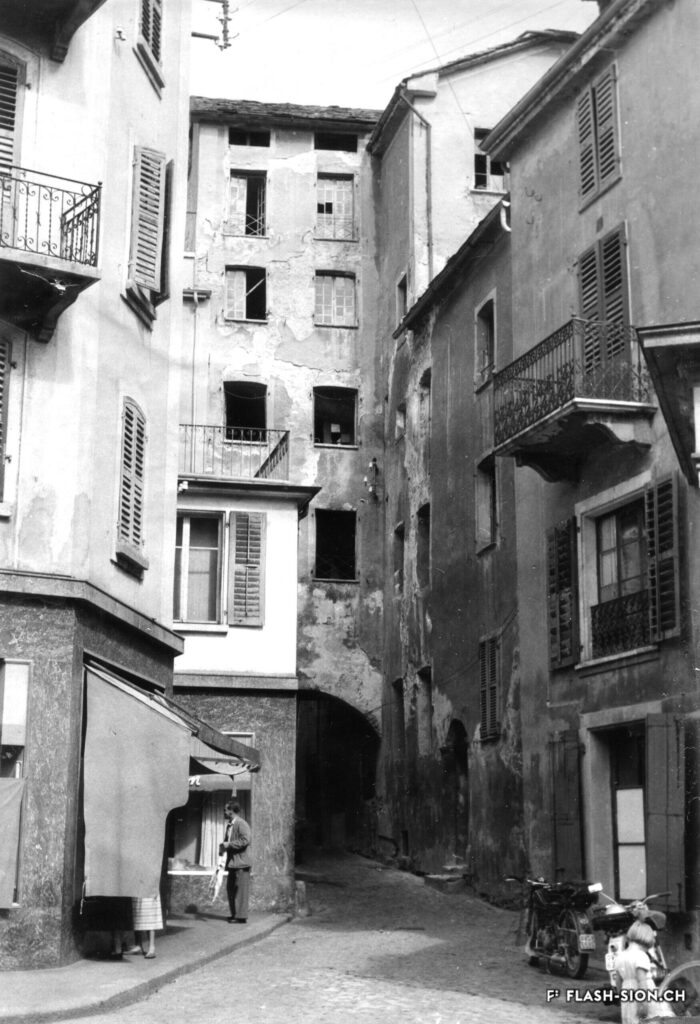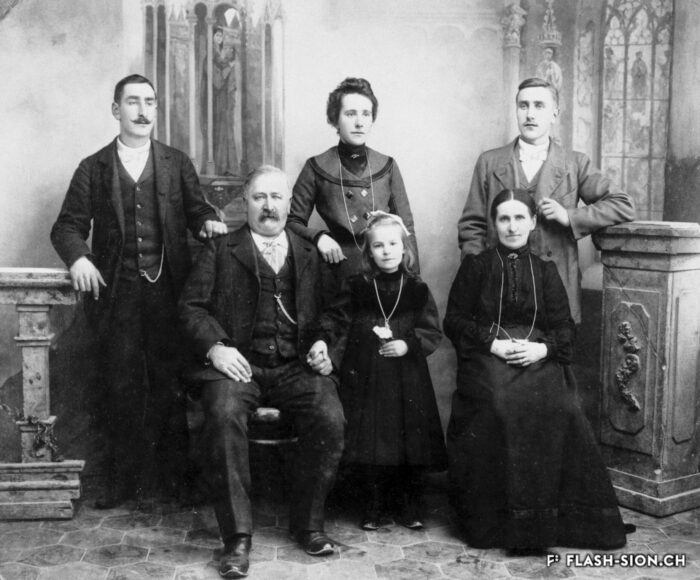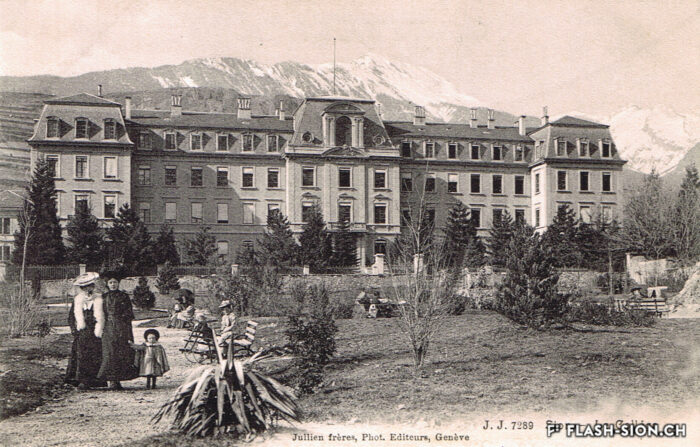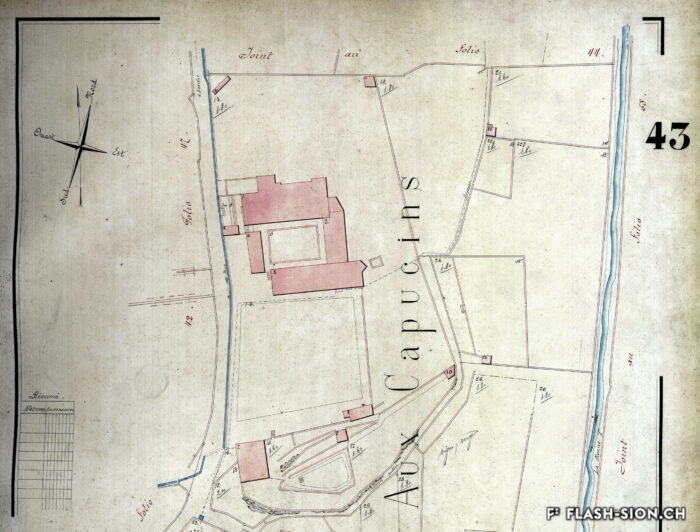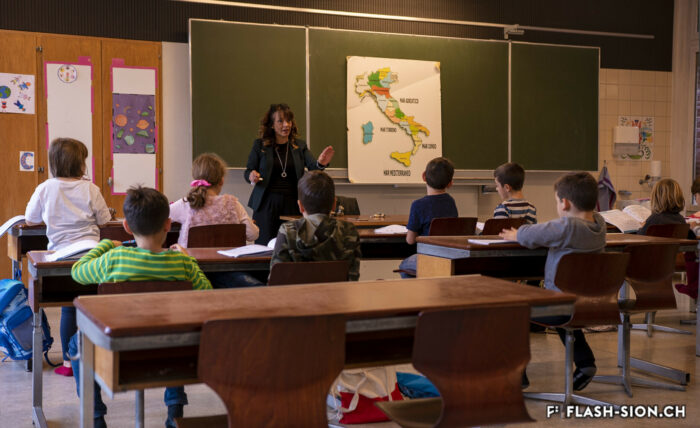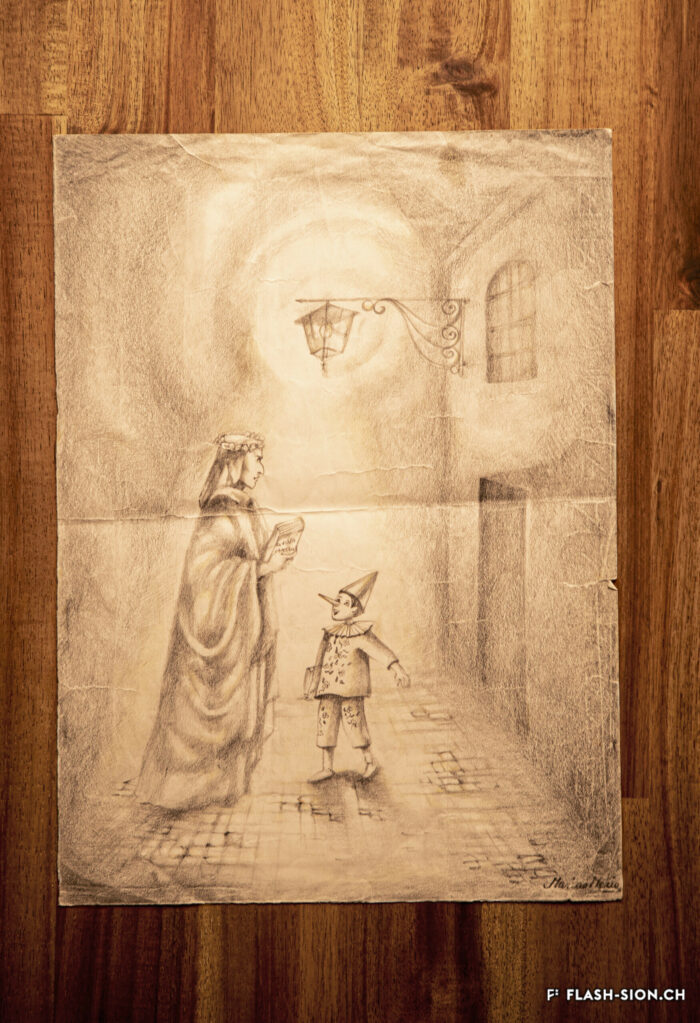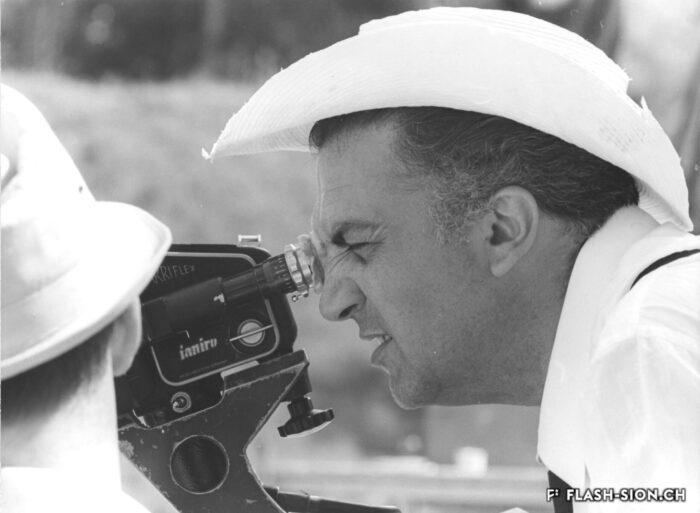Du culte du corps aux lieux de culte
Les fouilles archéologiques de St-Théodule au début des années 1960 révèlent une surprise de taille ! Sous l’église gothique actuelle, œuvre de reconstruction inachevée de l’illustre maître-maçon transalpin Ulrich Ruffiner, les archéologues découvrent non seulement les ruines de trois édifices religieux antérieurs, mais également les vestiges de thermes romains. Infrastructure balnéaire caractéristique de la vie sociale de la Rome antique, les thermes publics étaient placés à côté du forum. Ainsi, l’hypothèse de la présence d’une place publique au Glarier sous l’Empire romain est aujourd’hui avancée par les spécialistes.
Vom Köperkult zum Kultort
Die archäologischen Ausgrabungen von St.Theodul Anfang der 1960er Jahre hielten eine grosse Überraschung bereit! Unter den Mauern der bestehenden gotischen Kirche, die auf ein unvollendetes Projekt des berühmten Maurermeisters Ulrich Ruffiner zurückführt, entdeckten Archäologen nicht nur die Ruinen von drei früheren Sakralbauten, sondern auch Überreste einer römischen Therme. Die für das gesellschaftliche Leben im alten Rom charakteristische Badeinfrastruktur befand sich gewöhnlich neben dem Forum. So vertreten Wissenschaftler heute die Hypothese, dass während des römischen Reichs das Zentrum der Siedlung in Glarier gelegen haben könnte.
Cleanliness is next to godliness
The archaeological excavations at the church of St. Theodulus in the early 1960s uncovered a major surprise! Beneath the present-day Gothic church (an unfinished reconstruction by the renowned Italian master mason Ulrich Ruffiner), the archaeologists discovered not only the ruins of three earlier religious buildings, but also the remains of Roman baths. The public baths were a typical feature of social life in ancient Rome, and they were usually located beside the forum. This discovery has now prompted experts to suggest that there was a public square in Sion’s Glarier district under the Roman Empire.
Dal culto del corpo ai luoghi di culto
Gli scavi archeologici presso St-Théodule, all’inizio degli anni 60, svelano una sorpresa notevole! Sotto la chiesa gotica attuale, opera di ricostruzione incompiuta dell’illustre capomastro transalpino Ulrich Ruffiner, gli archeologi scoprono non solamente le rovine di tre edifici religiosi antecedenti ma anche vestigi di terme romane. Infrastruttura balneare caratteristica della vita sociale della Roma antica, le terme pubbliche erano collocate accanto al foro. Pertanto, oggi gli specialisti avanzano l’ipotesi della presenza di una piazza pubblica al Glarier sotto l’Impero Romano.
Des Lombards à Sion
A Sion, la présence de Lombards est attestée dès le 13e siècle. Actifs dans la banque et le commerce, ils prennent part au développement de la vie économique et politique sédunoise. Pourtant, la mention du quartier « en Lombardie » n’apparaît dans les écrits qu’à partir du 17e siècle, soit plusieurs siècles après leur installation. La rue qui porte leur nom est un hommage tardif. Une plaque commémorative posée au début de la rue de la Lombardie renforce encore ce souvenir des liens qui unissent le Valais et la Lombardie.
Lombarden in Sitten
In Sitten ist die Präsenz von Lombarden ab dem 13. Jahrhundert belegt. Sie betätigten sich als Kaufleute und Bankiers und waren massgeblich an der politischen und wirtschaftlichen Entwicklung der Stadt beteiligt. Der Name des Stadtteils “en Lombardie” tritt jedoch erst im 17. Jahrhundert in den Schriften auf. Die Strasse, die heute ihren Namen trägt, ist eine späte Hommage. Am Anfang der Rue de la Lombardie erinnert eine Gedenktafel an die Beziehungen zwischen der Lombardei und dem Wallis.
Lombards in Sion
There is evidence that Lombards were present in Sion from the 13th century onwards. They played an active part in banking and commerce, and they contributed to the development of Sion’s economic and political life. However, the city district known as “en Lombardie” is not mentioned in documentation until the 17th century – several centuries after the Lombards settled here. The street that bears their name is a belated tribute. A commemorative plaque installed at the start of Rue de la Lombardie is another reminder of the bonds that link Valais and Lombardy.
I lombardi a Sion
A Sion, la presenza dei lombardi è confermata dal 13° secolo. Attivi nel settore bancario e commerciale, prendono parte allo sviluppo della vita economica e politica di Sion.
Ciò nonostante, la menzione del quartiere “in Lombardia” appare negli scritti solo dal 17° secolo, ossia molti secoli dopo il loro insediamento. La via, che porta il loro nome, è un omaggio tardivo. Una targa commemorativa installata all’inizio della via “rue de la Lombardie” rafforza maggiormente il ricordo dei legami tra il Vallese e la Lombardia.
Un évêque valdôtain
Boniface de Challant, évêque de Sion de 1290 à 1308, est originaire de l’une des familles les plus puissantes du Val d’Aoste. Sachant manier avec énergie et fermeté la crosse et l’épée, il commandite la construction du château de Tourbillon, érigé au tournant du 13e siècle. Il s’inscrit ainsi dans la tradition familiale de « bâtisseurs de châteaux-forts », les Challant ayant déjà fait édifier de nombreuses forteresses dans leur vallée d’origine.
Ein Bischof aus dem Aostatal
Der zwischen 1290 und 1308 als Bischof von Sitten amtierende Bonifaz de Challant stammte aus einer der einflussreichsten Familien des Aostatals. Er handhabte Bischofsstab wie Schwert mit Tatkraft und Entschlossenheit und blieb der Familientradition der “Burgenbauer” treu. Gelten doch die Challants als Auftraggeber zahlreicher Festungen in ihrer Heimatregion. Der Bau der Burganlage von Tourbillon, die um die Wende des 13. Jahrhunderts entstanden ist, wird allgemein Bonifaz de Challant zugeschrieben.
A bishop from Val d’Aosta
Boniface de Challant, Bishop of Sion from 1290 to 1308, came from one of the most powerful families in Val d’Aosta. As a vigorous and resolute wielder of the crook and the sword, he sponsored the construction of Tourbillon Castle, built at the turn of the 13th century. In so doing, he followed the family tradition of “builders of fortified castles”: the Challant family had already commissioned many fortresses in their home valley.
Un vescovo valdostano
Bonifacio di Challant, vescovo di Sion dal 1290 al 1308, proviene da una delle famiglie più potenti della Valle d’Aosta. Sapendo maneggiare con forza e fermezza il pastorale e la spada, commissiona la costruzione del castello di Tourbillon, eretto al volgere del 13° secolo. S’iscrive così a pieno titolo nella tradizione familiare dei “costruttori di fortezze”, visto che gli Challant avevano già fatto edificare numerose fortezze nella loro valle d’origine.
Le parfum du sud
Région la plus sèche de Suisse, le Valais central et la station météorologique de Sion enregistrent régulièrement des températures record. Sur les collines de Valère et Tourbillon, une végétation caractéristique des steppes continentales, mêlée à quelques espèces typiquement méditerranéennes, reflètent le climat d’une vallée intra-alpine. Dès le 16e siècle déjà, la faune et la flore exceptionnelles du site des collines suscitent l’intérêt des scientifiques et la valeur importante de ces milieux refuges demande aujourd’hui toute notre attention. Ponctuée par le chant des cigales en été, la présence d’espèces cultivées comme l’amandier, le figuier ou encore le grenadier, ajoute à l’agréable souvenir du Sud qui s’en dégage.
Der Duft des Südens
Als trockenste Region der Schweiz bekannt, verzeichnen das Zentralwallis und die Wetterstation von Sitten regelmässig Rekordtemperaturen. Auf den Felshügeln von Valeria und Tourbillon repräsentiert eine von mediterranen Arten durchzogene Steppenvegetation das kontinentale Klima eines inneralpinen Tales. Bereits seit dem 16. Jahrhundert wecken die aussergewöhnliche Fauna und Flora der Burghügel von Sitten das Interesse der Wissenschaftler. Die grosse Bedeutung als Zufluchtsort seltener Arten verlangt heute eine spezielle Rücksichtsname. Im Sommer haftet dem Ort durch den Gesang der Zikaden und Kulturpflanzen wie Mandel-, Feigen- und Granatapfelbaum eine angenehm südliche Note an.
Fragrances of the South
Central Valais is Switzerland’s driest region, and Sion’s meteorological station regularly registers record temperatures. On the Valère and Tourbillon hills, the climate of an inner Alpine valley fosters characteristic continental steppe vegetation mixed with some typically Mediterranean species. From the 16th century onwards, the interest of scientists was already aroused by the unusual fauna and flora present on these hills; nowadays too, these valuable and important refuge habitats merit our fullest attention. Pleasant memories of the South abound here, as the cicadas sing during summer amid cultivated species such as almond, fig and even pomegranate trees.
Il profumo del Sud
Considerata la regione più secca della Svizzera, il Vallese centrale e la stazione meteorologica di Sion registrano regolarmente delle temperature record. Sulle colline di Valère e Tourbillon, una vegetazione caratteristica delle steppe continentali, mischiata ad alcune specie tipiche della vegetazione mediterranea, rispecchia il clima di una valle intra-alpina. Già dal 16°secolo, la fauna e la flora eccezionali del sito delle colline suscitano l’interesse degli scienziati e il valore importante di questi luoghi, considerati come rifugio, richiede oggi tutta la nostra attenzione. Scandita dal canto delle cicale nel periodo estivo, la presenza di specie coltivate come il mandorlo, l’albero di fico o ancora il melograno, riportano la memoria alle terre del Sud.
De Jean-Baptiste à Marguerite
Jean-Baptiste Garbaccia ou Garbazzia (1790-1865) s’établit à Sion en tant que maître-maçon au début du 19e siècle. Piémontais originaire de Varallo, il fait de nombreux dons aux pauvres de la cité ainsi qu’aux établissements de charité. Cet homme généreux lègue également à la Municipalité divers bâtiments, dont l’imposante maison en bas de la ruelle qui porte aujourd’hui son nom. Démolie en 1954, cette bâtisse, un temps mise à la disposition des assistés, a laissé place à un espace baptisé en hommage à l’artiste et écrivaine Marguerite Burnat-Provins.
Von Jean-Baptiste zu Marguerite
Der Maurermeister Jean-Baptiste Garbaccia oder Garbazzia (1790-1865) siedelte sich Anfang des 19. Jahrhunderts in Sitten an. Der gebürtige Piemonteser aus Varallo zeichnete sich durch zahlreiche Spenden zu Gunsten von Mittellosen und Wohltätigkeitseinrichtungen der Stadt aus. Der grosszügige Bürger hinterliess der Gemeinde verschiedene Immobilien, darunter das imposante Haus in der Gasse, die heute seinen Namen trägt. Dieses diente einige Zeit als Unterkunft für Unterstützungsbedürftige der Stadt. Es wurde 1954 abgerissen und wich so einem Platz zu Ehren der Schriftstellerin Marguerite Burnat-Provins.
From Jean-Baptiste to Marguerite
Jean-Baptiste Garbaccia or Garbazzia (1790-1865) set up his business as a master mason in Sion at the start of the 19th century. This native of Varallo in Piedmont bestowed many gifts on the city’s poor and its charitable institutions. He also showed his generosity by bequeathing various buildings to the Municipality, including the impressive house at the bottom of the street that now bears his name. This building was placed at the disposal of people in need of social assistance before it was demolished in 1954; it made way for a space named in honour of Marguerite Burnat-Provins, the artist and writer.
Da Giovanni Battista a Marguerite
Giovanni Battista Garbaccia o Garbazzia (1790-1865) si stabilisce a Sion come capomastro all’inizio del 19° secolo. Piemontese, originario di Varallo, fa numerosi doni ai poveri della città così come ad enti di beneficenza. Uomo generoso fa dono al comune anche di diversi edifici, tra i quali l’imponente casa all’inizio del vicolo a lui intestato. Il palazzetto, distrutto nel 1954 e un tempo a disposizione degli assistiti, ha lasciato il posto ad un luogo che ha preso il nome dell’artista e scrittrice Marguerite Burnat-Provins.
Une affaire de famille
Entrepreneur piémontais né en 1845, Michel Fasanino œuvre à Sion dès son établissement en 1883. A cette époque, la ville ressemble davantage à un bourg agricole qu’à une cité urbaine. Jusqu’à son décès en 1923, Fasanino contribue notablement à son expansion. Il collabore également avec les deux architectes incontournables de l’époque, Joseph de Kalbermatten et Joseph Dufour. Ce patron bienveillant dirige son affaire prospère en bon père de famille et laisse de nombreuses réalisations, en partie disparues aujourd’hui.
Ein Familienunternehmen
Der 1845 geborene piemontesische Baumeister Michel Fasanino liess sich im Jahre 1883 in Sitten nieder. In der noch stark bäuerlich geprägten Stadt trug Fasanino bis zu seinem Tod im Jahre 1923 massgeblich zur Stadtentwicklung bei. Er arbeitete ebenfalls mit Joseph de Kalbermatten und Joseph Dufour zusammen. Diese gehörten zu den führenden Architekten jener Zeit. Der wohlwollende Arbeitgeber führte ein florierendes Geschäft und hinterliess ein umfassendes Lebenswerk, von dem heute zahlreiche Bauten abgebrochen worden sind.
A family business
Michel Fasanino, a Piedmont entrepreneur born in 1845, worked at Sion after setting up business there in 1883. In those days, Sion resembled an agricultural township rather than an urban centre. Fasanino played an outstanding part in the city’s expansion until his death in 1923. He also collaborated with the two most prominent architects of the period: Joseph de Kalbermatten and Joseph Dufour. This benevolent employer ran his prosperous business like a good family man. His legacy included many buildings, although some of them have since disappeared.
Un affare di famiglia
Imprenditore piemontese nato nel 1845, Michel Fasanino lavora a Sion sin dal suo insediamento nel 1883. A quell’epoca, la città assomiglia maggiormente ad un borgo agricolo che ad una città urbana. Fino alla sua morte nel 1923, Fasanino contribuisce in modo notevole all’espansione della città. Collabora con due architetti di spicco dell’epoca, Joseph de Kalbermatten e Joseph Dufour. Capo benevolo dirige la sua attività prospera come un buon padre di famiglia e lascia innumerevoli opere, ad oggi in parte distrutte.
Sion gravée dans la pierre
Important les compétences nécessaires au travail de la pierre, des marbriers et sculpteurs originaires du Val d’Ossola dominent le secteur dès la fin du 19e siècle et contribuent largement à l’essor de la ville du 20e siècle. En 1906, les frères Nichini déploient leur activité à Sion et marquent durant trois générations la construction en pierre de la cité. Exploitant d’une carrière à Bramois, Albert Nichini, devient par la suite propriétaire de la carrière d’Evolène, dont les pierres ornent de nombreux bâtiments et monuments de la ville.
Sion, in Stein gemeisselt
Ab Ende des 19. Jahrhunderts dominieren die für ihre Fachkenntnis bekannten Steinhauer und Steinmetze aus dem Val d’Ossola den Berufszweig der Steinbearbeitung und tragen massgeblich zur Stadtentwicklung im 20. Jahrhundert bei. Die Gebrüder Nichini nehmen im Jahr 1906 ihre Tätigkeit in Sitten auf und prägen über drei Generationen den Steinbau der Stadt. Vorerst Betreiber eines Steinbruchs in Bramois, erwirbt Albert Nichini später den Steinbruch von Evolène, dessen Steinplatten zahlreiche Gebäude und Denkmäler der Stadt schmücken.
Sion – carved in stone
Marble masons and sculptors from Val d’Ossola brought with them the skills needed to work with stone; they dominated the industry from the late 19th century onwards and played a key part in the city’s dynamic growth in the 20th century. The Nichini brothers set up their business at Sion in 1906 and for three generations, they left their mark on the city’s stone architecture. Albert Nichini operated a quarry at Bramois and then became the owner of the Evolène quarry, which supplied stone to decorate many of the city’s buildings and monuments.
Sion incisa nella pietra
Ritenute importanti le competenze necessarie al lavoro della pietra, marmisti e scultori originari della Val d’Ossola dominano il settore dalla fine del 19° secolo e contribuiscono notevolmente all’espansione della città del 20° secolo. Nel 1906, i fratelli Nichini sviluppano la loro attività a Sion e segnano per tre generazioni il settore della costruzione in pietra della città. Esercente di una cava a Bramois, Albert Nichini diventa in seguito il proprietario della cava di Evolène, le cui pietre abbelliscono numerosi edifici e monumenti della città.
La construction dans les gènes
Depuis l’Antiquité, bâtisseurs, maître-maçons et entrepreneurs italiens marquent la construction en pierre de la cité sédunoise et du Valais. Reconnus pour leur savoir-faire artisanal et leur force de travail exemplaires, des entrepreneurs italiens feront également partie, en 1919, des membres fondateurs de l’Association Valaisanne des Entrepreneurs. Si ces « étrangers » seront perçus comme une menace lors des grandes crises économiques du 20e siècle, le secteur de la construction compte aujourd’hui encore de nombreux entrepreneurs d’origine transalpine.
Das Bauwesen im Blut
Seit der Antike prägen italienische Baumeister, Maurermeister und Unternehmer die Steinbauweise der Stadt Sitten und des Wallis. Bekannt für ihr handwerkliches Können und ihre unermüdliche Arbeitskraft, gehören 1919 ebenfalls italienische Baumeister zu den Gründungsmitgliedern des Walliser Baumeisterverbandes. Zwar werden diese “Fremdarbeiter” während den grossen Wirtschaftskrisen des 20. Jahrhunderts als Bedrohung wahrgenommen, doch prägen noch heute zahlreiche italienischstämmige Unternehmer den Bausektor.
Building is in their genes
Since ancient times, Italian builders, master masons and contractors have left their mark on the stone architecture that typifies the city of Sion and Valais canton. Italian contractors were renowned for their craftsmanship and their outstanding labour force; in 1919, they were also among the founding members of the Valais Association of Building Contractors. These “foreigners” were viewed as a threat during the major economic crises of the 20th century, but today’s construction sector still includes many contractors who trace their origins to the southern side of the Alps.
L’edilizia nei geni
Dall’antichità, costruttori, capimastri e imprenditori italiani segnano il settore della costruzione in pietra della città di Sion e del Vallese. Riconosciuti per il loro know-how, le loro competenze nell’artigianato e la loro forza lavoro esemplari, gli imprenditori italiani faranno parte nel 1919 dei membri fondatori dell’Associazione vallesana degli Imprenditori. Se questi “stranieri” sono considerati come una minaccia durante le grandi crisi economiche del 20° secolo, il settore dell’edilizia conta ancora oggi numerosi imprenditori di origine transalpina.
Un point de rencontre italo-sédunois
Institution historique et lieu de rassemblement, la Colonia Italiana réunit la communauté des Italiens de Sion dans son bâtiment de la rue de la Majorie depuis plus de soixante ans. Le foyer italien est fondé en 1958 sous l’impulsion de groupes actifs sur les plans sportif et artistique. Leur souhait est de disposer d’un lieu pour se réunir et partager leurs traditions. Rencontres culinaires, expositions, animations culturelles et autres activités rythment depuis lors la vie de ce lieu italo-sédunois.
Begegnungsort der Italienischen und Sittener Gemeinde
Seit mehr als 60 Jahren versammelt sich die italienische Gemeinde in der Colonia Italiana an der Rue de la Majorie. Die geschichtsträchtige Institution und der Treffpunkt von Italienern und Italienerinnen aus Sitten wurde 1958 auf Anregung verschiedener in Sport und Kultur tätigen Gruppen gegründet. Sie hatten das Bedürfnis einen Begegnungsort zu schaffen, wo sie sich treffen und austauschen konnten. Kulinarische Anlässe, Ausstellungen, kulturelle Veranstaltungen sowie weitere Aktivitäten prägen seither das Leben des “Italo-Sittener” Vereinslokals.
Where Italy meets Sion
The Colonia Italiana building in Rue de la Majorie is a historic institution where Sion’s Italian community has gathered together for over 60 years. This Italian centre was founded in 1958 at the initiative of various groups involved in sports and the arts. They wanted a place to meet and share their traditions. This venue where Italy meets Sion stages a regular programme of culinary events, exhibitions, cultural entertainment and other activities.
Un punto di ritrovo italo-sedunese
Istituzione storica e luogo di ritrovo, la Colonia italiana raduna la comunità degli Italiani di Sion nell’edificio in “rue de la Majorie” da oltre sessant’anni. Il focolare italiano è stato fondato nel 1958 sotto l’impulso di gruppi attivi nel campo sportivo e artistico. Il loro intento è quello di disporre di un luogo per riunirsi e condividere le proprie tradizioni. Incontri culinari, mostre, animazioni culturali e altre attività scandiscono da quel momento la vita di questo luogo italo-sedunese.
Un monument d’importance (inter-)nationale
Le travail du Vénitien Mirco Ravanne ne passe pas inaperçu au couvent des Capucins. L’architecte est appelé au début des années 1960 par le père Damien qui le charge de transformer et d’agrandir l’édifice religieux. A l’avant-garde à l’époque, son intervention résolument moderne vient contraster avec les structures de la bâtisse du 17e siècle tout en les respectant. Ravanne ne néglige aucun détail que ce soit dans l’architecture ou dans le mobilier « made in Italy ». Aujourd’hui, le couvent, propriété de la Bourgeoisie, est considéré comme son œuvre architecturale majeure.
Ein Denkmal von (inter-)nationaler Bedeutung
Die Arbeit des Venezianers Mirco Ravanne sorgte für Aufruhr im Kapuzinerkloster von Sitten. Der Architekt wurde Anfang der 1960er Jahre vom Guardian Pater Damien mit der Umgestaltung und Erweiterung der Klosteranlage beauftragt. Sein avantgardistischer Eingriff steht auf den ersten Blick in starkem Kontrast mit der historischen Struktur der Anlage aus dem 17. Jahrhundert, vermag aber bei genauerem Hinschauen eindrücklich zwischen Alt und Neu zu vermitteln. Ravannes Liebe zum Detail offenbart sich sowohl in seiner Architektur als auch in der von ihm entworfenen Ausstattung “Made in Italy”. Heute gilt das im Besitz der Burgergemeinde befindliche Kapuzinerkloster als das bedeutendste Werk des Architekten.
A monument of national and international importance
Visitors to the Capuchin Monastery are bound to admire the work of the Venetian architect Mirco Ravanne. In the early 1960s, Father Damien commissioned him to transform and extend this religious building. The architect took a decidedly modern, avant-garde approach to his work, which contrasts with the 17th-century structures of the building but also shows respect for them. Ravanne paid full attention to every detail, both in the architecture and the “made in Italy” furnishings. The monastery, which now belongs to the Bourgeoisie (municipality), is regarded as his architectural masterpiece.
Un monumento d’importanza (inter-)nazionale
L’operato del Veneziano Mirco Ravanne non passa di certo inosservato al convento dei Cappuccini. L’architetto è chiamato all’inizio degli anni 60 dal padre Damien che gli affida il compito di trasformare e ampliare l’edificio religioso. All’epoca all’avanguardia, il suo intervento decisamente moderno contrasta con le strutture dell’edificio del 17° secolo pur rispettandole. Ravanne non trascura alcun dettaglio sia nell’architettura che nel mobilio “made in Italy”. Ad oggi, il convento, proprietà della Borghesia, è considerato come la sua operata architettonica maggiore.
Mangia che ti fa bene
Le « Boccalino » ouvre ses portes en 1968 à la rue de Conthey. Il est le premier établissement sédunois à mettre à l’honneur la pizza, plat symbole de toute une nation. Des épiceries aux noms italiens existaient par ailleurs en vieille ville dès le début du 20e siècle, tels que Zoni&Schmidt, Zanoli ou encore Guido Nichini. Ce dernier, spécialisé dans la charcuterie et salaisons « exclusivement italiennes » avait à l’origine pignon sur la « via regia », une des appellations de l’actuelle rue de Conthey.
Mangia che ti fa bene
Das Restaurant “Boccalino” wurde 1968 in der Rue de Conthey eröffnet. Es war das erste Restaurant der Stadt, das sich ganz dem italienischen Nationalgericht, der Pizza, verschrieb. Seit Anfang des 20. Jahrhunderts sind in der Altstadt von Sitten auch Lebensmittelgeschäfte mit italienischen Namen wie Zoni&Schmidt, Zanoli und Guido Nichini bekannt. Letzterer hatte sich insbesondere auf italienische Wurst- und Pökelwaren spezialisiert und führte seinen Feinkostladen ursprünglich an der “Via Regia”, wie die heutige Rue de Conthey ebenfalls genannt wurde.
Mangia che ti fa bene
The Boccalino opened on Rue de Conthey in 1968. It was the first restaurant in Sion to feature pizza – the iconic dish of an entire nation. Elsewhere in the old town, there had been grocery stores with Italian names such as Zoni&Schmidt, Zanoli and Guido Nichini since the early 20th century. Nichini, which specialised in “exclusively Italian” cooked and cured meats, originally fronted onto the “via regia”, one of the names for the street now known as Rue de Conthey.
Mangia che ti fa bene
Il “Bocccalino” apre le sue porte nel 1968 nella “rue de Conthey”. È il primo stabilimento di Sion ad omaggiare la pizza, piatto simbolo di tutta una nazione. Botteghe con nomi italiani esistevano d’altronde nella città vecchia già all’inizio del 20° secolo, come Zoni&Schmidt, Zanoli oppure Guido Nichini. Quest’ultimo, specializzato in prodotti di salumeria e carni affumicate “esclusivamente italiane” possedeva un negozio nella “via regia”, uno dei nomi dell’attuale “rue de Conthey”.
Studio, studi, studia…
Initiés par le gouvernement italien en 1971, les cours de langue et de culture italienne deviennent une institution incontournable, à Sion notamment. Ils garantissent une identité culturelle aux jeunes de la seconde génération et favorisent leur insertion dans les structures socio-culturelles locales. De plus, cette école reflète à merveille la volonté de maintenir vivant le lien qui unit le pays d’émigration et la cité d’accueil.
Studio, studi, studia…
1971 von der Italienischen Regierung initiiert, wurden die Schulen für Italienische Sprache und Kultur schweizweit zu einer eigentlichen Institution – so auch in Sitten. Sie vermitteln den jungen Menschen der zweiten Generation eine kulturelle Identität und fördern die Integration in die lokalen Strukturen. Darüber hinaus zeigt die Italienische Schule von Sitten den Wunsch, die Beziehung zwischen Herkunftsland und Gaststadt aufrechtzuerhalten.
Studio, studi, studia…
In 1971, the Italian government launched a series of Italian language and culture courses that have become an invaluable institution at Sion in particular. The courses ensure that second-generation youngsters benefit from a cultural identity, encouraging them to integrate into local socio-cultural structures. This school is also a superb expression of the desire to maintain a living link between immigrants’ country of origin and their host city.
Studio, studi, studia…
Avviati dal governo italiano nel 1971, i corsi di lingua e cultura italiana diventano un’istituzione imprescindibile, in particolare a Sion. Questi tutelano un’identità culturale ai giovani della seconda generazione e favoriscono il loro inserimento nelle strutture socioculturali locali. Inoltre, i corsi rispecchiano alla perfezione la volontà di mantenere vivo il legame che unisce il paese d’immigrazione e la città di accoglienza.
L’Occhio, le journal des Italiens
En 1986, un groupe de jeunes Italiens de Sion se lancent le défi de publier un journal pour informer leurs compatriotes. Cette chronique bilingue est éditée en français et en italien jusqu’en 1993. Pour les auteurs, il s’agit de montrer leur respect envers leur cité d’accueil et de mieux faire connaître leur culture d’origine aux Sédunois. Ces journalistes en herbe abordent entre autres les activités de la colonie italienne et les sorties culturelles, réalisent des portraits de personnalités italiennes et nous mettent l’eau à la bouche avec leurs recettes en fin de journal.
L’Occhio, die Zeitschrift der Italiener und Italienerinnen
Eine Gruppe italienischer Jugendlicher stellt sich 1986 der Herausforderung, eine Zeitung zur Information ihrer Landsleute herauszugeben. Die bis 1993 veröffentlichte Zeitschrift erscheint zweisprachig – auf italienisch und französisch. Damit bekundet das Redaktionsteam ihrer Gaststadt nicht nur seine Wertschätzung, sondern bringt den Einheimischen ebenfalls ihren kulturellen Hintergrund näher. Die Jung-Journalisten thematisieren unter anderem die Aktivitäten der Colonia Italiana sowie weitere kulturelle Anlässe. Sie präsentieren Porträts italienischer Persönlichkeiten und lassen der Leserschaft auf der letzten Seite mit ihren Rezepten buchstäblich das Wasser im Munde zusammenlaufen.
L’Occhio – the Italians’ magazine
In 1986, a group of young Italians at Sion took on the challenge of publishing a magazine to provide information for their compatriots. This bilingual periodical was published in French and Italian until 1993. The contributors aimed to show their respect for their host city, and to make their home culture better known to the people of Sion. Topics addressed by these budding journalists included the activities of the Italian community as well as cultural events; they painted portraits of prominent Italian figures and whetted our appetites with their recipes at the end of the magazine.
L’Occhio, il giornale degli italiani
Nel 1986, un gruppo di giovani italiani di Sion decidono di pubblicare un giornale informativo destinati ai connazionali. La cronaca bilingue viene redatta in francese e in italiano fino al 1993. L’intento degli autori era quello di mostrare il proprio rispetto nei confronti della città di accoglienza e di far conoscere agli abitanti di Sion la loro cultura di origine. Questi giornalisti in erba si occupano tra l’altro delle attività della colonia italiana e delle gite culturali, dipingono i ritratti delle personalità italiane e ci mettono l’acquolina in bocca con le ricette nelle ultime pagine del giornale.
Evviva il Maestro
L’œuvre du réalisateur italien Federico Fellini est au cœur des activités de la Fondation Fellini pour le cinéma. Cette dernière possède un fonds de plus de 15’000 documents dont les 2/3 environ concernent l’œuvre du maestro. Depuis sa création en 2001, cette fondation organise des expositions en Suisse et à travers le monde. Elle permet ainsi au public de découvrir la richesse du travail du réalisateur en mettant en évidence les liens entre cinéma, littérature, photographie, architecture et musique. L’espace culturel ouvert en 2011 à la Maison du Diable apporte une touche méridionale supplémentaire à Sion.
Evviva il Maestro
Das Werk des italienischen Regisseurs Federico Fellini steht im Mittelpunkt der Aktivitäten der Stiftung Fellini. Diese verfügt über eine Sammlung von über 15’000 Dokumenten, von denen etwa zwei Drittel die Arbeit des Maestros betreffen. Seit ihrer Gründung im Jahr 2001 organisiert die Stiftung Ausstellungen in der Schweiz und auf der ganzen Welt. Ziel ist es, den Reichtum des Werkes des Regisseurs in Zusammenhang mit Kino, Literatur, Fotografie, Architektur und Musik aufzuzeigen. Mit der Eröffnung des Kulturraums in der “Maison du Diable” im Jahr 2011 erhielt Sittens südlicher Einschlag eine weitere Bereicherung.
Evviva il Maestro
The Fellini Foundation for Cinema focuses on the work of Federico Fellini, the Italian film director. It owns a collection of over 15,000 documents, about two thirds of which relate to the maestro’s work. The Foundation has staged exhibitions in Switzerland and across the globe since it was set up in 2001. It enables the public to explore the wealth of the director’s work by highlighting links between the cinema, literature, photography, architecture and music. The cultural centre, opened in 2011 at the Maison du Diable, brings yet another hint of the South to Sion.
Evviva il Maestro
L’opera del regista italiano, Federico Fellino, è il fulcro delle attività della Fondazione Fellini per il cinema. Quest’ultima possiede una collezione di più di 15’000 documenti, i cui 2/3 circa riguardano l’opera del maestro. Dalla sua nascita, nel 2001, la fondazione organizza delle mostre in Svizzera e attraverso il mondo. Permette in tal modo al pubblico di scoprire la ricchezza del lavoro del regista mettendo in risalto i legami tra cinema, letteratura, fotografia, architettura e musica. Lo spazio culturale aperto nel 2011 alla Casa del Diavolo offre un tocco meridionale rilevante a Sion.
